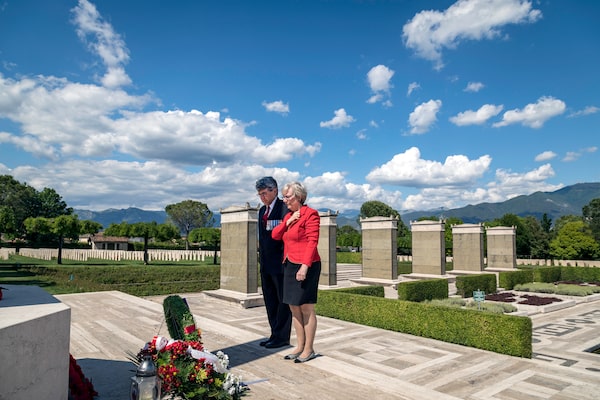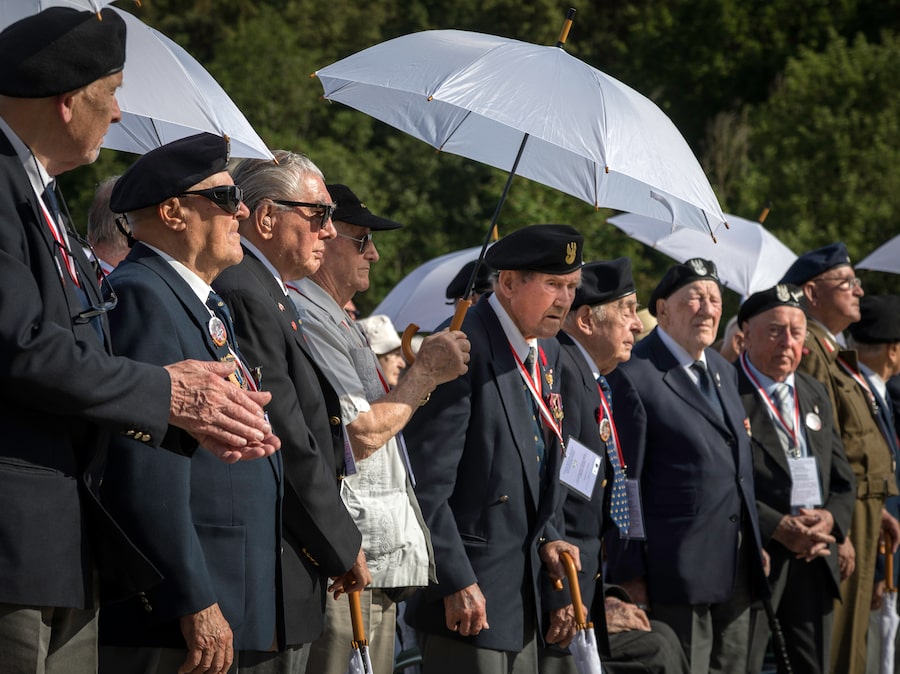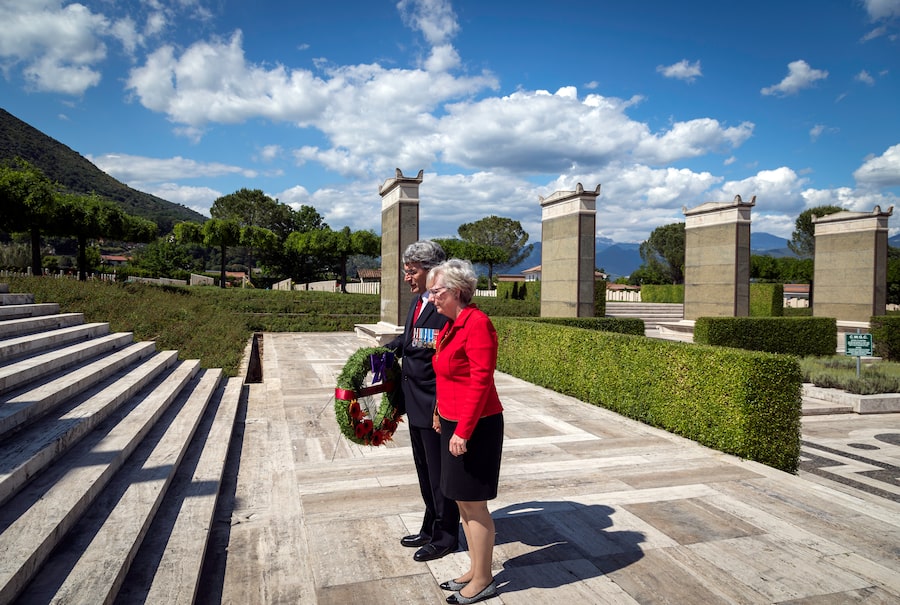
The Abbey of Monte Cassino sits more than 500 metres atop a hill overlooking the town of Cassino and the graves of Canadian soldiers buried in the Cassino War Cemetery.JOHN SOPINSKI/THE GLOBE AND MAIL
A few minutes before 11 in the morning, Waclaw Fieglar walked slowly into the heart of the ancient Benedictine abbey of Monte Cassino, pushing a walker to steady himself. His smart blue blazer was festooned with eight war medals; a pin on his right lapel depicted the Polish and Canadian flags.
Taking in the grandeur of the enormous rebuilt mountaintop abbey – the thick, cream-coloured stone columns, the vaulted ceilings forming the arcades, the lush greenery of the courtyard – Mr. Fieglar looked astonished. “Exactly 74 years ago today, to this very hour, I was here,” he said. “It was just rubble. There was only one wall standing.”
Mr. Fieglar, sturdy for his age, with a full head of hair and bushy eyebrows, was pumped up with a shot of cortisone to relieve back pain. He is 96, has lived in Canada since 1966 and is the father-in-law of Canada’s ambassador to Italy, Alexandra Bugailiskis, and the father of Alex Fieglar, a retired Canadian Armed Forces lieutenant-colonel.
Last Friday, he was one of 20 Polish veterans, three of them Polish-Canadians, to visit the abbey to celebrate the 74th anniversary of the end of the Battle of Monte Cassino, one of the bloodiest clashes of the Second World War. Hundreds of Canadians were among the horrific number of casualties in the epic battle.

Polish-Canadian veteran of Monte Cassino, Waclaw Fieglar, listens as a guide speaks off camera inside the cathedral at the Abbey of Monte Cassino.JOHN SOPINSKI
After five months of fighting by the Allied forces – composed of Americans, British, Canadians, Free French, Australians, New Zealanders, South Africans, Indians, Nepalese, Moroccans and Poles – it was the Poles who finally took the abbey, or what little was left of it. The abbey, once the Catholic Church’s greatest monastery, was the focal point of the Gustav Line, the German army’s formidable defensive line half way between Rome and Naples.
While the Allies ultimately won the battle, allowing them to enter Rome in June, 1944, it came at a huge cost.
Various historical records say the Allies took 55,000 casualties during the Monte Cassino campaign, almost three times higher than the German casualties. The Poles paid a horrific price for their final assault. In the shadow of the abbey lies the Polish Cemetery, with 1,051 graves, including the grave of the Polish army general, Wladyslaw Anders, who commanded the Polish 2nd Corps throughout the Italian campaign (he died in 1970 and had wished to be buried at the site of his greatest victory).
“Anders’ Army,” as it was known, fills Poles with pride to this day and Mr. Fieglar was part of it. General Anders’ daughter, Anna Maria Anders, a senator and secretary of state in the Polish government, attended the Monte Cassino remembrance ceremonies, an event that becomes more emotionally difficult for her every year as the number of veterans dwindles. Two years ago, 32 veterans attended the ceremony. Last year, there were 22; this year 20. With the youngest of the veterans in their early nineties, next year’s big 75th anniversary event no doubt will see fewer still.

Anna Maria Anders arrives at the Abbey of Monte Cassino.
“At Monte Cassino, the Poles were fighting for freedom far away from their home,” Ms. Anders told The Globe and Mail. “It was a huge victory for the Poles and put Poland on the fighting map.”
Poland was ripped apart by the German and Soviet armies in the Second World War and virtually no family emerged unscathed (about six million Poles died – 20 per cent of the prewar population). Mr. Fieglar’s family was shattered by the war. His survival is something of a miracle, given his perilous odyssey from Poland to Italy by way of central Asia and the Middle East.
Mr. Fieglar was born in eastern Poland (now in western Ukraine) in 1921, the son of a small-town mayor. After the Soviet invasion of Poland in 1939, the entire Fieglar family was exiled to a slave labour camp in Kazakhstan, then a Soviet republic. When Adolf Hitler turned against Joseph Stalin in 1941 and invaded the Soviet Union, the Soviets gave the Poles in Kazakhstan the choice of staying in the camps “to die of starvation and sickness,” according to Fieglar family notes, or join an expatriate Polish army to fight the Germans. That army would be formed in Uzbekistan under General Anders.
Mr. Fieglar and his brother made it to Samarkand, in eastern Uzbekistan, in late 1941. Overcome by typhoid, Mr. Fieglar’s brother died. Mr. Fieglar himself almost succumbed to typhoid and malaria but was able to make it to General Anders’s staging site. The new Polish army’s first assignment was to protect the Kirkuk oilfields in Iraq, north of Baghdad, from German attack (Kirkuk was not attacked). In Iraq, Mr. Fieglar learned to use British-made Vickers anti-aircraft guns and was enlisted into an anti-aircraft regiment.
The next stop was Palestine, where he completed his officer’s training. Mr. Fieglar remembers that one of the Poles who crossed into Palestine with General Anders’s army was Menachem Begin, who would fight in the 1948 Arab-Israeli war and become Israel’s prime minister in 1977.
In early February, 1944, four months before the D-Day landings in Normandy, it was finally time for the Poles to join the campaign to liberate Europe from the Nazis. They went from Palestine to Egypt, then across the Mediterranean to Taranto, in the extreme south of Italy, which was occupied by the British 8th Army.

Canadian Ambassador to Italy, Alexandra Bugailiskis and her husband, Lieutenant-Colonel (Ret.) Alexander Fieglar, pay their respects after laying a wreath at the Cassino War Cemetery where more than 4,000 Commonwealth soldiers are buried.JOHN SOPINSKI/THE GLOBE AND MAIL
By then, the Battle of Monte Cassino was already well under way, with disastrous results for the Allies, who had vastly underestimated the strength of the German defences along the Gustav line. The U.S. 5th Army, under General Mark Clark, took such heavy losses – the 36th Division suffered 2,100 casualties in one 48-hour period alone in January – that the officers’ conduct during the battle would became the subject of a U.S. Congressional inquiry.
On Feb. 15, 1944, the Americans, mistakenly thinking that the abbey itself was occupied by German soldiers, used B-17 bombers to obliterate the monastery, which was founded in the 6th century and would become one of the medieval world’s greatest artistic, cultural and medical centres. “We watched the monastery get destroyed,” Mr. Fieglar said. “It was a barbaric thing.”
Its destruction was considered perhaps the greatest single aesthetic disaster of the war and was entirely counterproductive. By agreement with the Vatican, the Germans had not occupied the abbey but were happy to do so after it was reduced to rubble. Burrowing into the ruins with their guns, they were virtually unassailable.
Mr. Fieglar was never on the front lines of the battle, but his regiment fought around the clock only a few kilometres away. Its soldiers directed their 3.7-inch anti-aircraft guns on German ammunition dumps, road crossings, warehouses and other fixed targets – softening up the German defenses in preparation for the final assault on Monte Cassino that would be made on May 17 and May 18, 1944. “We were so tired from shooting that we’d fall asleep next to the guns and not hear them firing,” he said.
An hour after General Anders’s fighters reached the top of Monte Cassino, Mr. Fieglar and three other Polish officers jumped into a Jeep and drove along a former donkey trail to the abbey.

The Monastery at Monte Cassino, as seen from the German lines, shows that only the outer walls have survived the Allied bombing on Feb. 29, 1944.Keystone/Getty Images

The Abbey of Monte Cassino as seen from the Polish Military Cemetery.JOHN SOPINSKI/THE GLOBE AND MAIL
“Along the way, we saw bodies, probably Polish bodies, covered in flies,” he said. “Wherever there were flies, there were bodies. We saw so much destruction, no trees, everything bare, every stone broken from the barrages. But we saw red flowers. The Poles wrote a song about these red flowers.”
The red flowers were poppies and Poles repeatedly sang their song, The Red Poppies of Monte Cassino, during the ceremony on Friday.
Traipsing through the ruins, Mr. Fieglar found five postcards, three of the abbey and two from elsewhere that had been addressed to residents of the abbey. He took them as “trophies,” he said. At the 72nd anniversary of the battle, in 2016, he presented the postcards to the abbot of Monte Cassino and begged for forgiveness for having taken them. The abbot not only forgave him, but blessed him for having preserved the postcards, which are now on display in the Monte Cassino museum.
After the battle of Monte Cassino, Mr. Fieglar kept fighting all the way up to Ancona, the Adriatic port in central Italy. Even before the war ended, he finished his studies in Italy, met a young, multilingual Greek woman named Adelaide at his Rome hotel and married her in Rome in 1946. After Mr. Fieglar was demobilized from the Polish army in Britain, where their daughter Diana was born, they emigrated to Argentina, the birthplace of their son, Alex.
Almost two decades later, as Argentina was collapsing economically, they went to Canada, arriving with virtually nothing. Starting with menial jobs, Adelaide eventually became a translator and Mr. Fieglar a quality assurance inspector at a printing firm. In North Toronto, where they lived, they were able to build a solid middle-class life. Last year, they moved to Rome with their son and their daughter-in-law and live in the Canadian official residence in Rome. It’s a grand residence, but both Mr. Fieglar and his wife say they miss the city that gave them a new life.
The anniversary ceremonies at Monte Cassino were held on a warm day under blazing sun. Polish soldiers, dignitaries and priests in their finest garb toured the abbey and chatted with the veterans, including several Polish female medics, before a commemorative mass was held at the Polish cemetery late in the afternoon. One of the medics, Krystyna Farley, 92, was beaming with pride. “The Allies were here for six months and nothing happened,” she said. “Then the Poles came. They had a couple of drinks, charged up the mountain and won.”

Monte Cassino veteran and Kitchener, Ont., resident Edward Moczulski stands in front of an interior courtyard at the Abbey of Monte Cassino on May 18, 2018.
Mr. Fieglar was thrilled to be with his few remaining war colleagues, especially the two Polish-Canadian vets. One was Edward Moczulski, 92, who lives in Kitchener, Ont.; the other was Paul Lojko, 91, of Brantford, Ont., who was in a wheelchair. He was only 18 during the battle of Monte Cassino, making him the baby of the veterans.
While the veterans celebrated their war victory, Ms. Bugailiskis, the Canadian ambassador, made sure the Canadians who fought along the Gustav Line were not forgotten. She and her husband broke away and drove down the mountain to the Cassino War Cemetery, where the remains of almost 4,300 Commonwealth soldiers, including 855 Canadians, are buried. She laid a wreath next to the Canadian monument. There were no other visitors at the cemetery.
Up the mountain, in the abbey, all the adulation was making Mr. Fieglar feel a bit uncomfortable. “I was no hero,” he said. “The heroes are in the cemetery.”

MONTE CASSINO:
gateway to rome
The Benedictine Abbey of Monte Cassino (Abbazia di Montecassino) traces its origins to the 6th Century. Perched on a hill more than 500 metres above the town of Cassino, it proved a cornerstone in the formidable German Gustav Line of defenses stretching across Italy from the Adriatic to Tyrrhenian Seas. It overlooks the entrance to the Liri river valley and during the war provided the German defenders the high ground giving them a distinct advantage over Allied forces trying to break through and push toward Rome. The abbey was finally liberated by Polish forces on May 18, 1944, after five months of bloody fighting.
Adriatic Sea
Ortona
Rome
Gustav Line
Cassino
Anzio
Bari
ITALY
Naples
Ionian
Sea
Tyrrhenian Sea
0
100
KM
Polish
Military
Cemetery
Abbey of
Monte Cassino
SR 149
Cassino
JOHN SOPINSKI/THE GLOBE AND MAIL
SOURCE: history.com; world war II
database; 3d map generator; google maps

MONTE CASSINO: gateway to rome
The Benedictine Abbey of Monte Cassino (Abbazia di Montecassino) traces its origins to the 6th Century. Perched on a hill more than 500 metres above the town of Cassino, it proved a cornerstone in the formidable German Gustav Line of defenses stretching across Italy from the Adriatic to Tyrrhenian Seas. It overlooks the entrance to the Liri river valley and during the war provided the German defenders the high ground giving them a distinct advantage over Allied forces trying to break through and push toward Rome. The abbey was finally liberated by Polish forces on May 18, 1944, after five months of bloody fighting.
Adriatic Sea
Ortona
Rome
Gustav Line
Cassino
Anzio
Bari
ITALY
Naples
Ionian
Sea
Tyrrhenian Sea
0
100
KM
Polish
Military
Cemetery
Abbey of
Monte Cassino
SR 149
Cassino
JOHN SOPINSKI/THE GLOBE AND MAIL
SOURCE: history.com; world war II
database; 3d map generator; google maps

MONTE CASSINO: gateway to rome
The Benedictine Abbey of Monte Cassino (Abbazia di Montecassino) traces its origins to the 6th Century. Perched on a hill more than 500 metres above the town of Cassino, it proved a cornerstone in the formidable German Gustav Line of defenses stretching across Italy from the Adriatic to Tyrrhenian Seas. It overlooks the entrance to the Liri river valley and during the war provided the German defenders the high ground giving them a distinct advantage over Allied forces trying to break through and push toward Rome. The abbey was finally liberated by Polish forces on May 18, 1944, after five months of bloody fighting.
Ortona
Polish
Military
Cemetery
Rome
Gustav Line
Cassino
0
Anzio
Bari
ITALY
Abbey of
Monte Cassino
Naples
KM
5
Ionian
Sea
Tyrrhenian Sea
0
100
SR 149
Monte Cairo
(1,699m)
KM
GERMANS
Cassino
LAZIO
Piedimonte
San Germano
To Rome
Caira
Rapido Valley
Liri Valley
ALLIES
Cassino
Cassino War
Cemetery
JOHN SOPINSKI/THE GLOBE AND MAIL
SOURCE: history.com; world war II
database; 3d map generator; google maps
Editor’s note: An earlier version of this story incorrectly said Monte Cassino was the largest and longest land battle of the Second World War.





















 Eric Reguly
Eric Reguly